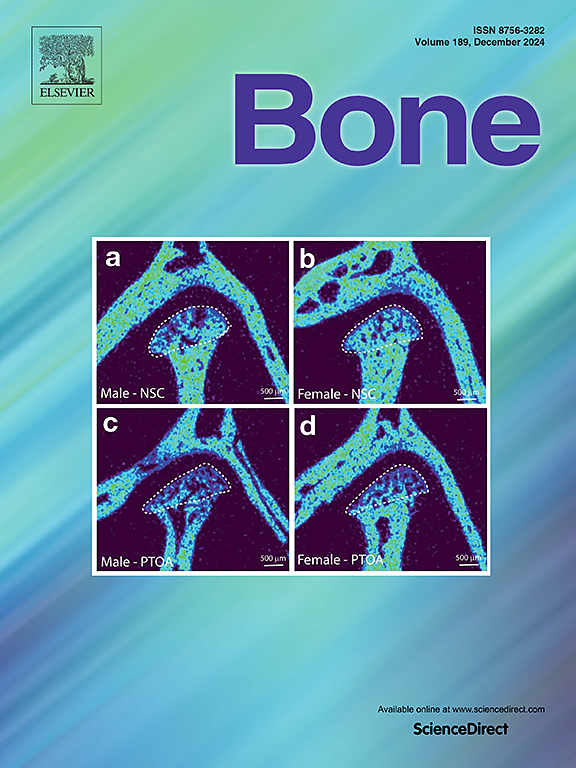The protection of nicotinamide riboside against diabetes mellitus-induced bone loss via OXPHOS
IF 3.5
2区 医学
Q2 ENDOCRINOLOGY & METABOLISM
引用次数: 0
Abstract
Diabetes mellitus is a global disease that results in various complications, including diabetic osteoporosis. Prior studies have indicated a correlation between low levels of nicotinamide adenine dinucleotide (NAD+) and diabetes-related complications. Nicotinamide riboside (NR), a widely utilized precursor vitamin of NAD+, has been demonstrated to enhance age-related osteoporosis through the Sirt1/FOXO/β-catenin pathway in osteoblast progenitors. However, the impact of NR on bone health in diabetes mellitus remains unclear. In this study, we assessed the potential effects of NR on bone in diabetic mice. NR was administered to high-fat diet (HFD)/streptozotocin (STZ)-induced type 2 diabetic mice (T2DM), and various parameters, including metabolic indicators, bone quality, bone metabolic markers, and RNA sequences, were measured. Our findings confirmed that HFD/STZ-induced T2DM impaired bone microstructures, resulting in bone loss. NR effectively ameliorated insulin resistance, improved bone microarchitecture, and bone quality, reduced bone resorption, enhanced the Forkhead box O (FOXO) signaling pathway, mitigated the nuclear factor kappa B (NF-kB) signaling pathway, and ameliorated the disorder of the oxidative phosphorylation process (OXPHOS) in diabetic mice. In conclusion, NR demonstrated the capacity to alleviate T2DM-induced bone loss through the modulation of OXPHOS in type 2 diabetic mice. Our results underscore the potential of NR as a therapeutic target for addressing T2DM-related bone metabolism and associated diseases. Further cell-based studies under diabetic conditions, such as in vitro cultures of key cell types (e.g., osteoblasts and osteoclasts), are necessary to validate these findings.

烟酰胺核苷对糖尿病所致骨质流失的保护作用。
糖尿病是一种全球性疾病,可导致各种并发症,包括糖尿病性骨质疏松症。先前的研究表明,低水平的烟酰胺腺嘌呤二核苷酸(NAD+)与糖尿病相关并发症之间存在相关性。烟酰胺核苷(Nicotinamide riboside, NR)是一种广泛应用的NAD+前体维生素,已被证明可通过成骨细胞祖细胞的Sirt1/FOXO/β-catenin通路增强年龄相关性骨质疏松症。然而,NR对糖尿病患者骨健康的影响尚不清楚。在这项研究中,我们评估了NR对糖尿病小鼠骨骼的潜在影响。采用高脂饮食(HFD)/链脲佐菌素(STZ)诱导的2型糖尿病小鼠(T2DM)给予NR,测定代谢指标、骨质量、骨代谢标志物、RNA序列等参数。我们的研究结果证实,HFD/ stz诱导的T2DM损伤骨微结构,导致骨质流失。NR可有效改善糖尿病小鼠胰岛素抵抗,改善骨微结构,改善骨质量,降低骨吸收,增强叉头盒O (FOXO)信号通路,减轻核因子κ B (NF-kB)信号通路,改善氧化磷酸化过程的紊乱。综上所述,NR能够通过调节2型糖尿病小鼠的OXPHOS来减轻t2dm诱导的骨质流失。我们的研究结果强调了NR作为治疗t2dm相关骨代谢和相关疾病的治疗靶点的潜力。进一步在糖尿病条件下进行基于细胞的研究,如关键细胞类型(如成骨细胞和破骨细胞)的体外培养,是验证这些发现的必要条件。
本文章由计算机程序翻译,如有差异,请以英文原文为准。
求助全文
约1分钟内获得全文
求助全文
来源期刊

Bone
医学-内分泌学与代谢
CiteScore
8.90
自引率
4.90%
发文量
264
审稿时长
30 days
期刊介绍:
BONE is an interdisciplinary forum for the rapid publication of original articles and reviews on basic, translational, and clinical aspects of bone and mineral metabolism. The Journal also encourages submissions related to interactions of bone with other organ systems, including cartilage, endocrine, muscle, fat, neural, vascular, gastrointestinal, hematopoietic, and immune systems. Particular attention is placed on the application of experimental studies to clinical practice.
文献相关原料
公司名称
产品信息
索莱宝
water-saturated phenol
索莱宝
sodium acetate
 求助内容:
求助内容: 应助结果提醒方式:
应助结果提醒方式:


